The Importance of the Eyes
It cannot be understated that the eyes in a Korean Jindo is extremely important.
On the old Korean National Dog Association site under "How to Appreciate the Jindo Dog", there's this line, "In detail examination, the Jindo Dog's eyes should be look at first."
A judge (Judge Kim, Jong Hyun?) at an old Jindo Dog Association of America seminar stated that when selecting between only Jindos (versus between mixes and pures), the eyes has the importance of 70% of the dog.
Sharpness of Eyes
"Eyes should be black with sharp focus." - old KNDA website
The first part of the sentence is easy to understand, but what exactly does sharp focus mean?
"Sharp focus" can apply in two ways.
This description can be a reflection of the dog's mental state. It's desired that Jindos maintain a level focus - reflecting the dog's
ability to concentrate during hunts. Eyes that flick side to side can be considered a sign of either weak nerves or poor socialization.
This description can also apply to the literal physical focusing of the eyes. In full sun, the ability to quickly narrow the pupil to tiny pin-points is highly valued.
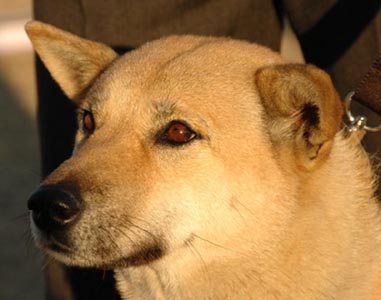
YeonDu, a female champion at a dog show in Korea.
At nightime, a person should be able to see clear through to the back of the
eye on dogs with excellent night vision. There should be no cloudiness preventing that viewing. (Old age, cataracts, and eye
damage can lead to cloudiness in the eye.)
As the Jindo dog is a hunting dog, hunting in both day and night, the response of the pupil controlling the amount of light entering the
eye is necessary for sharp vision. A rapid response of the pupil is necessary for the dog to maintain focus in variable light when pursuing prey.
Shape and Placement of Eyes
In general, there are two different interpretations for the shape of the eye. Almond or round. Both require the outer corners pointing slightly upwards towards the edge of the ears.
a bit rounder |
a bit more almond-shaped |
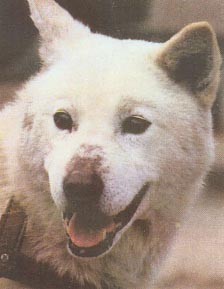
Pipi - photo by Woo, Mu Jong |
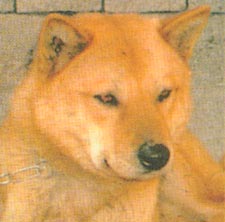
Sanchul - photo by Woo, Mu Jong
|
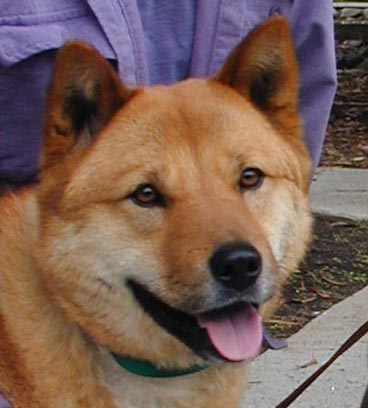
Woody - photo by Ann Kim |
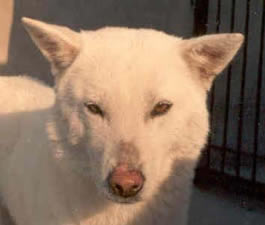
Ppiru - photo by Woo, Mu Jong
|
One description that is not preferred is triangular, with the bottom eyeline being very straight and long. That would give the impression of a Japanese breed, not a Korean breed.
Japanese Kishu |
Japanese-style Akita |
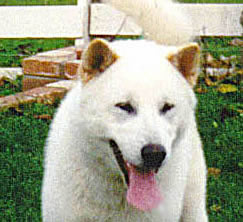 Munchie - photo by Jon Buijten Munchie - photo by Jon Buijten |
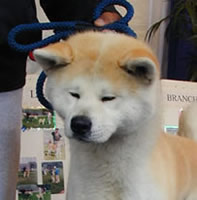
Taisho-Go - photo by Ann Kim
|
The eyes are well set inside the head. This is to protect the eyes as the dog is running through brush or when fighting an animal.
The Jindo is a breed that has sexual dimorphism, which means that there are outward differences between males and females. It's generalized that females have big eyes while males have smaller eyes. This may be a relative description, but the males'
stronger brows, bone structures and wider heads do give off the impression that their eyes are smaller than a females'.
Color of Eyes
Reddish-black irises, often compared to the color of jujubees, have become favored due to the "better hunter" belief, but brown is still the common color. There are certain preferred brown shades that are difficult to capture on camera. There are also some Jindos that appear to have almost golden eyes.
No Jindo should have blue eyes. It's said that long ago there used to be grey eyes in white Jindos, but these are considered extinct in the breed.
| Jujubees. Also known as Asian dates. These fruits are often dried and added in desserts or herbal medicine to sweeten the flavor. |
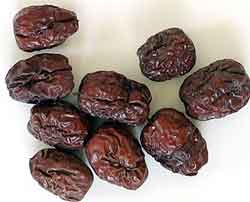
Dried jujubees |
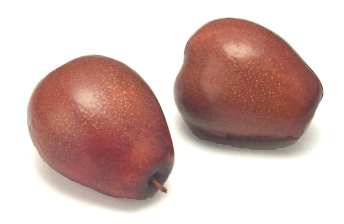
Fresh jujuees |
There has sometimes been confusion about blue eye color vs. the light reflecting out of a Jindo's eyes. This is the glow that one sees when taking a picture of a Jindo with flash. Healthy, hunting dogs usually have a bright glow that is green-gold or blue-green.
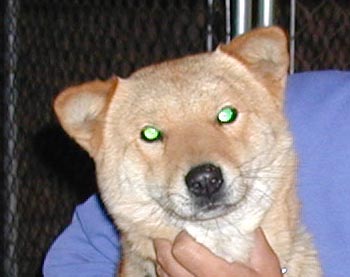
OhBong - photo by Ann Kim |
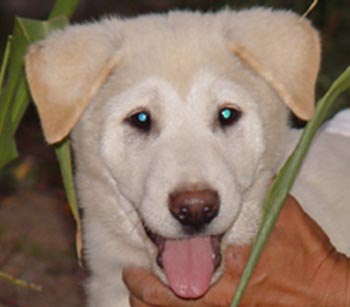
Bong - photo by Johnathan Lee? |
Dogs that have a red glow lack an eye feature called the tapeum lucidum and are believed to have lesser night vision.
Dogs normally have two traits that allow for superior night vision than humans. They have a greater proportion of contrast-sensitive
cones in their eyes than humans (at the expense of color-sensitive rods). They also have the reflective tapeum lucidum that allows
light to pass though the retina twice and increase the sensitive of the eye in low levels of light. The red eye glow is caused by the absence of tapeum lucidum and therefore the showing of retina blood vessels.
Miscellaneous Eye characteristics
"infinite depths, and no strength or aggressiveness shown from its outside but strength of heart staying in the inside" - anonymous, 2002
"Upward glance, sharp, powerful" - roughly translated, Kim Jong Hyun 1999?
It's desired by certain groups that the pupil of the eye be located directly below the eyelid. What would be needed to have this
positioning? Probably a combination of deep-set eyes and lowered head. The powerful glance comes from the inner strength of the dog though.
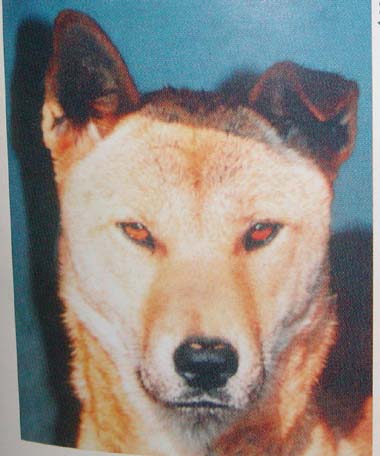
Kerry
Photo is said to have come from an older book.
The intensity and strength of this hunting dog's
eyes makes him desirable even with his other
weaknesses. |
Character Revealed in the Eyes
Old-time Jindo breeders believe that through the examination of the eyes, the internal character of the dog can be revealed. For
instance, through the examination of the eyes, a person can tell whether a dog is a calm, accepting dog or a manipulative, crafty dog. They can tell if the dog angers easily and tell of the intensity of his anger when aroused. They can tell if a dog is a fearful or courageous dog without knowing anything about the dog or seeing it in person.
How can someone determine character by the eyes without even meeting the dog?
Coming from a Western perspective, I realized that evaluating character by just looking at the eyes may sound a bit unscientific. Coming from an American perspective, I realize that it may sound even a bit prejudice as American culture believes in "not judging a book by its cover." It's an area for potential conflicts.
Let me try to bridge the gap with the examination of one trait of the Jindo - the dominant temperament. This dominant temperament and the behaviors associated with it can be observed by the owner of a dominant dog, and a modification of this eye=character philosophy can be experienced by the watchful owner of a dominant dog.
When a typical dog desires to establish dominance over another dog, s/he gives off certain signals before acting out and escalating to a fight. Some signals are a stiffen posture, a walking on toes, a position facing the rival, a low growl, and lastly, a hard stare. When a typical dog of any breed becomes possessive of food, they stiffen up over their food, give a barking-growl, and give a hard stare.
When the rare, truly self-assured dog (Jindo or otherwise) expresses dominance, s/he does not need to give more than a look to convey their point.
People sometimes lament that the Asian breeds like the Jindo, Akita, and even the Chow don't give warnings before they bite. I would contend that for some of these cases, they do give warnings initially, but they are missed by their human owners as they are communicated solely by the eyes.
If people can read how dominant a dog is through their eyes, it may be possible to read other traits as well if only if the person has the training and experience to look for them.






 Munchie - photo by Jon Buijten
Munchie - photo by Jon Buijten




